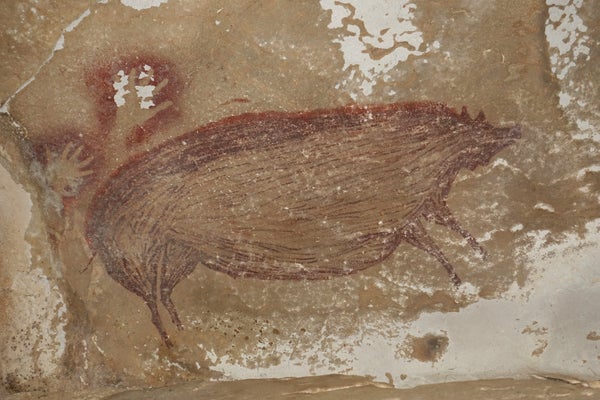In the Western imagination, ancient cave paintings tend to conjure images of Lascaux, the cave complex in southwestern France that is famous for its exceptionally detailed depictions of humans and animals. The Lascaux paintings, however, are a mere 17,000 years old. The oldest known examples of figurative art, or imagery that shows more than just abstractions, occur in Southeast Asia. Now a painting of pigs discovered in a cave in Indonesia sets a new record for the earliest figurative art—at least 45,500 years old—according to research published on Wednesday in Science Advances.
“We stress that this is only a minimum age,” says co-author Maxime Aubert, a professor of archeological science at Griffith University in Australia. “The rock art in this region could very well be 60,000 to 65,000 years old. We just need more samples.”
Sulawesi, an Indonesian island east of Borneo where the latest painting was found, is a treasure trove for rock art. Since researchers began working there 70 years ago, they have confirmed around 300 caves containing imagery. In late 2019 Aubert and his colleagues dated a Sulawesi cave painting depicting a hunting scene to at least 43,900 years ago—the oldest known painting in the region at the time.
On supporting science journalism
If you're enjoying this article, consider supporting our award-winning journalism by subscribing. By purchasing a subscription you are helping to ensure the future of impactful stories about the discoveries and ideas shaping our world today.
It is usually challenging to determine when ancient art was made. But the limestone composition of Sulawesi’s caves makes it easier to date paintings that occur there. Porous limestone promotes the formation of speleothems, or mineral deposits formed by water precipitating through rock. Stalactites and stalagmites are examples of speleothems, but microscale deposits can also build up on cave walls, including sections that contain artwork.
Dating technology for Pleistocene paintings works by measuring the ratio of uranium and thorium (which forms as uranium decays) in mineral deposits collected atop ancient art. Scientists use known radioactive decay rates of the two elements to calculate the minimum amount of time that has passed since they were deposited.
The new painting—a series of three to four Sulawesi warty pigs and an outline of human hands—was discovered by Basran Burhan, a doctoral student and co-author of the study, in an isolated valley reachable only by foot. After taking precautions to ensure the collected samples were untouched, the authors calculated that the images must have been made at least 45,500 years ago.
“This is an important contribution,” says James O’Connell, an emeritus professor of anthropology at the University of Utah, who was not involved in the research. “The results echo and extend the time range for previously reported Late Pleistocene imagery from Sulawesi.”
No one knows when anatomically modern humans arrived on Sulawesi, so the new discovery is also significant in that it provides evidence of people’s presence in the region tens of thousands of years ago, says Kira Westaway, a geochronologist and Quaternary scientist at Macquarie University in Australia, who was not involved in the research. “Usually stone tools and fossils dug from sedimentary sections provide the oldest evidence of modern humans, and the dating of the rock art lags behind,” she says. “This is the only country in which its art is its oldest evidence.”
The depiction of Sulawesi warty pigs, Westaway adds, implies that these animals were important to ancient humans. “This research, in combination with the body of work produced by [the authors] in the last few years, greatly contributes to our understanding of modern humans in the region,” she says.
But Paul Pettitt, a Paleolithic archeologist at Durham University in England, who was also not involved in the research, says that while the art itself is impressive, the authors’ approach to science “does give me reservations about the reliability of what they publish.”
Specifically, he says, minimum ages are just that—minimums—and cannot definitively be used to claim discovery of “the world’s oldest figurative art.” He adds that, given the paucity of anatomically modern human fossils in the region, scientists cannot rule out the possibility that the works were created by another human species. We do need to see a little less rushing to publish on the basis of a couple of dates and its associated hyperbole—and a little more integrated rigor—before we start rewriting prehistory,” Pettitt says.
Aubert says that he and his colleagues understand that these are minimum values. “There could be sites in the world that could be older. We don’t know,” he says. “But we have to look at the fact that for the evidence we have at the moment, this is the oldest minimum age for rock art.”
